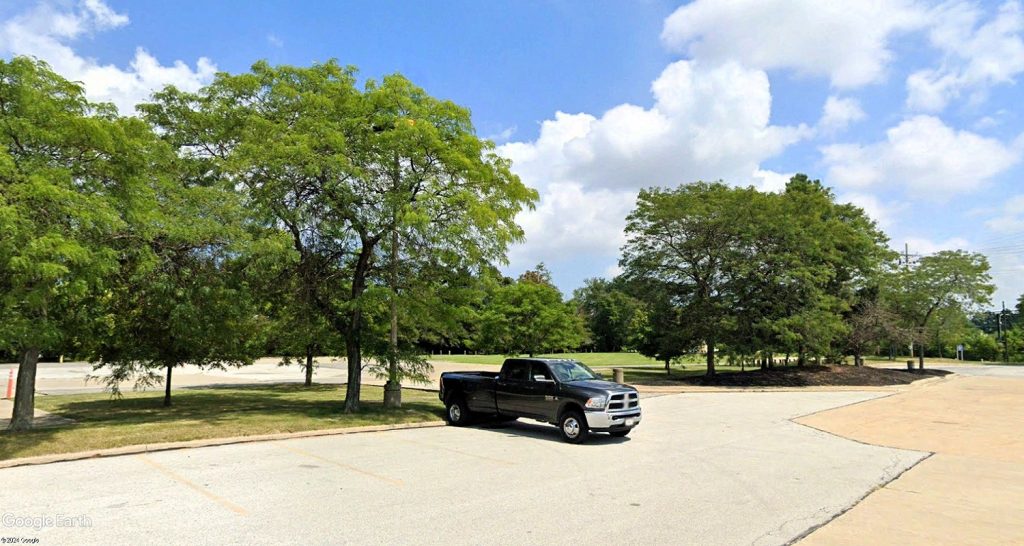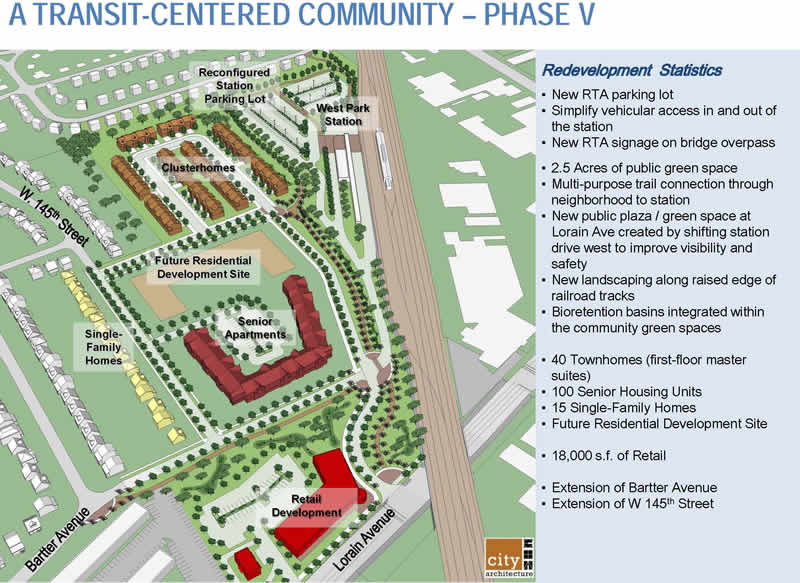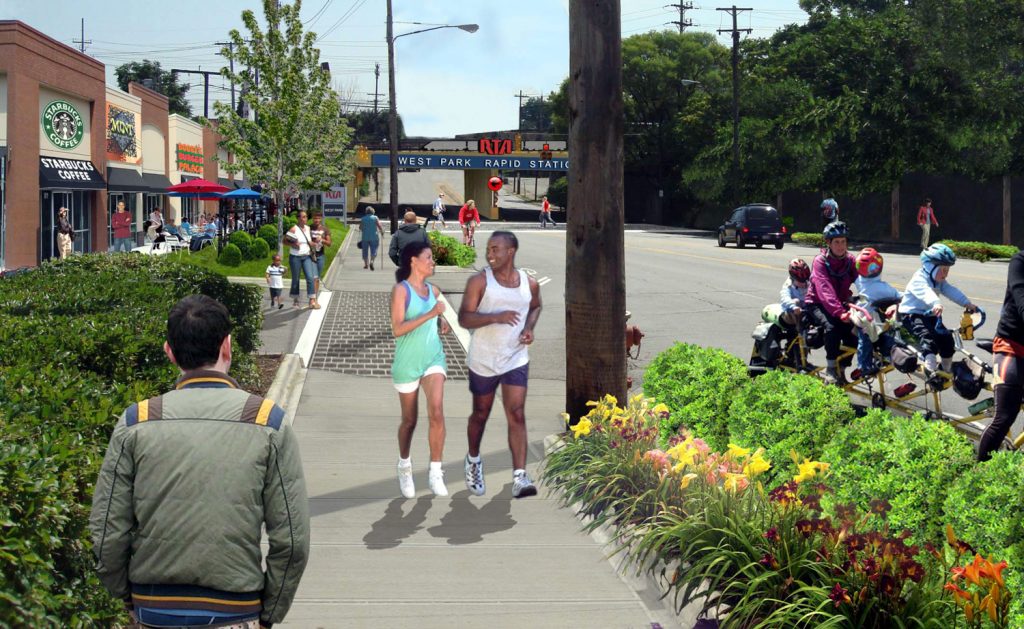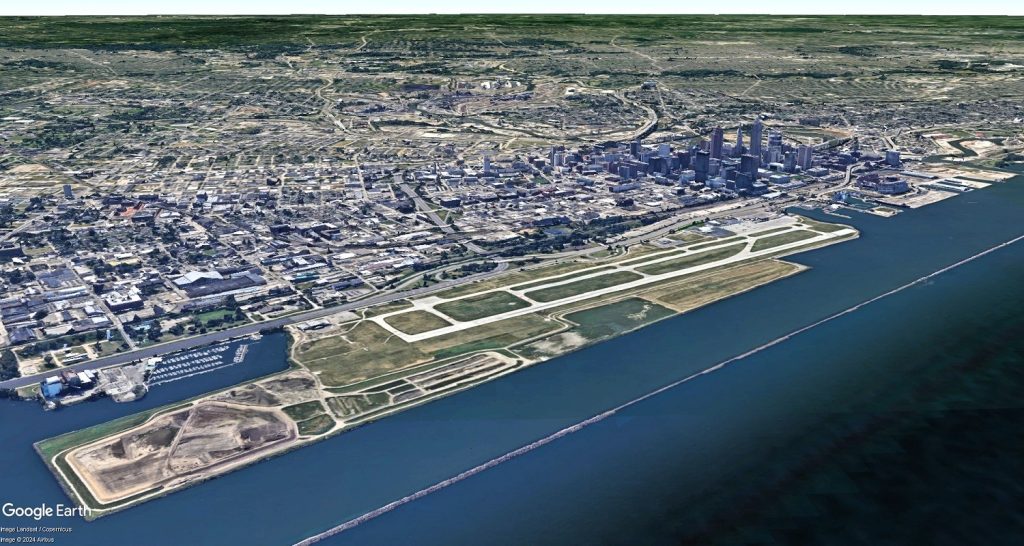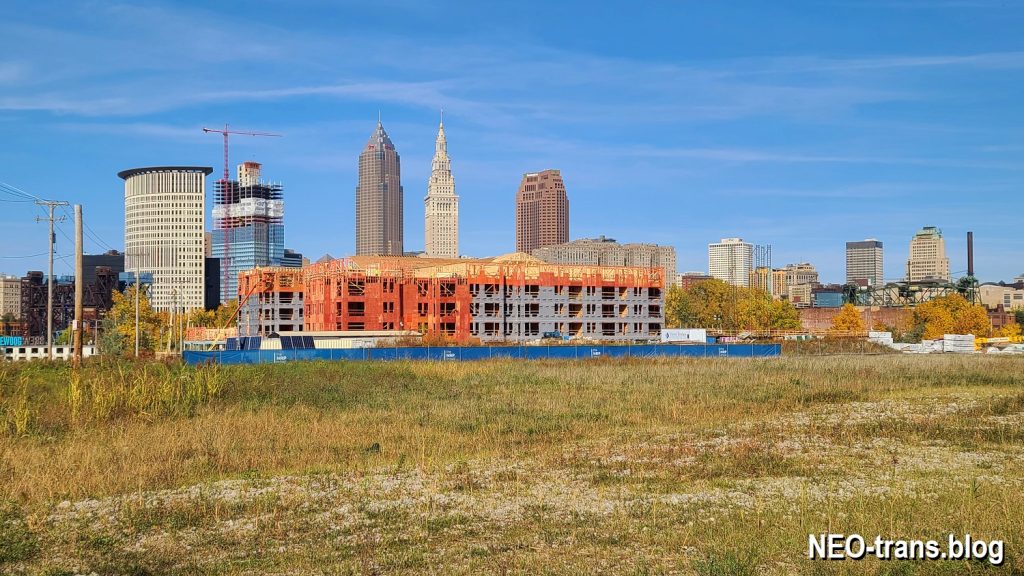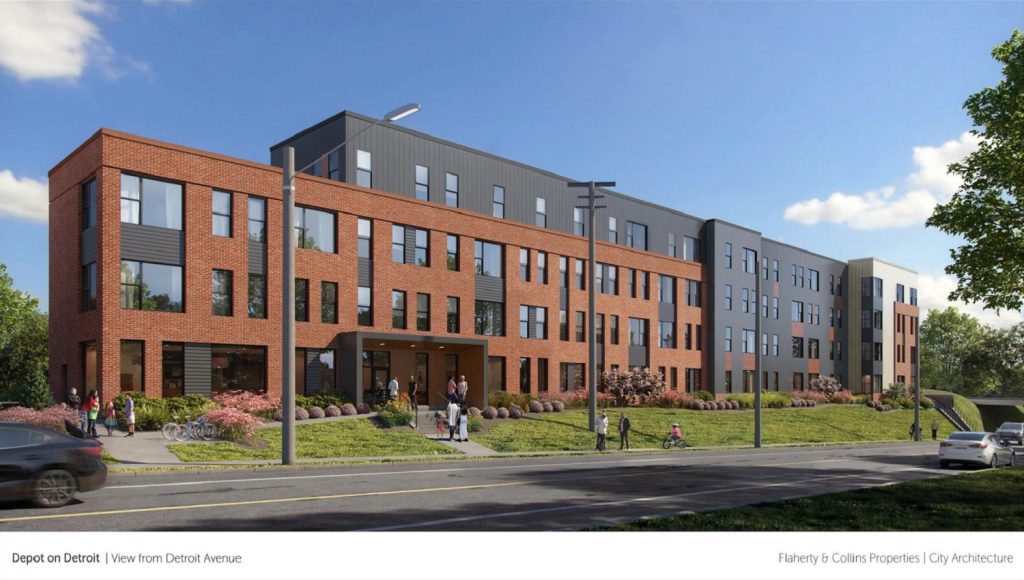
Three Red Line stops away from the West Park train station is the West Boulevard-Cudell station where Flaherty & Collins plans to build the Depot on Detroit apartments. The same developer now is planning a similarly sized apartment development at the West Park station, too (City Architecture). CLICK IMAGES TO ENLARGE THEM.
Next TOD project up for GCRTA Board action
Four days after receiving City Planning Commission approval for one transit-oriented development project, an Indianapolis-based developer will ask to buy land from the Greater Cleveland Regional Transit Authority (GCRTA) for its next proposed apartment building at a west-side train station. This time, Flaherty & Collins Development LLC wants to build at GCRTA’s West Park station, 14510 Lorain Ave.
Proposed is a 60- to 70-unit affordable apartment building at the northeast corner of GCRTA’s West Park station property, located in Cleveland’s Jefferson neighborhood. Flaherty & Collins is asking GCRTA’s Board of Trustees approve on Tuesday an option to acquire 1.35 acres of its underutilized, 15-acre station grounds.
The proposed development site is a mostly grassy area immediately south of homes that are along the south side of Tuckahoe Avenue. A dollar-amount for the land purchase is not yet available.
But part of the site also includes a paved area that was historically used for training GCRTA bus drivers. Most of the training area will be retained, however, as will as a 351-space park-and-ride lot for Red Line passengers that has seen its use decrease in recent years, and especially since the sharp decline of downtown employment beginning with the pandemic.
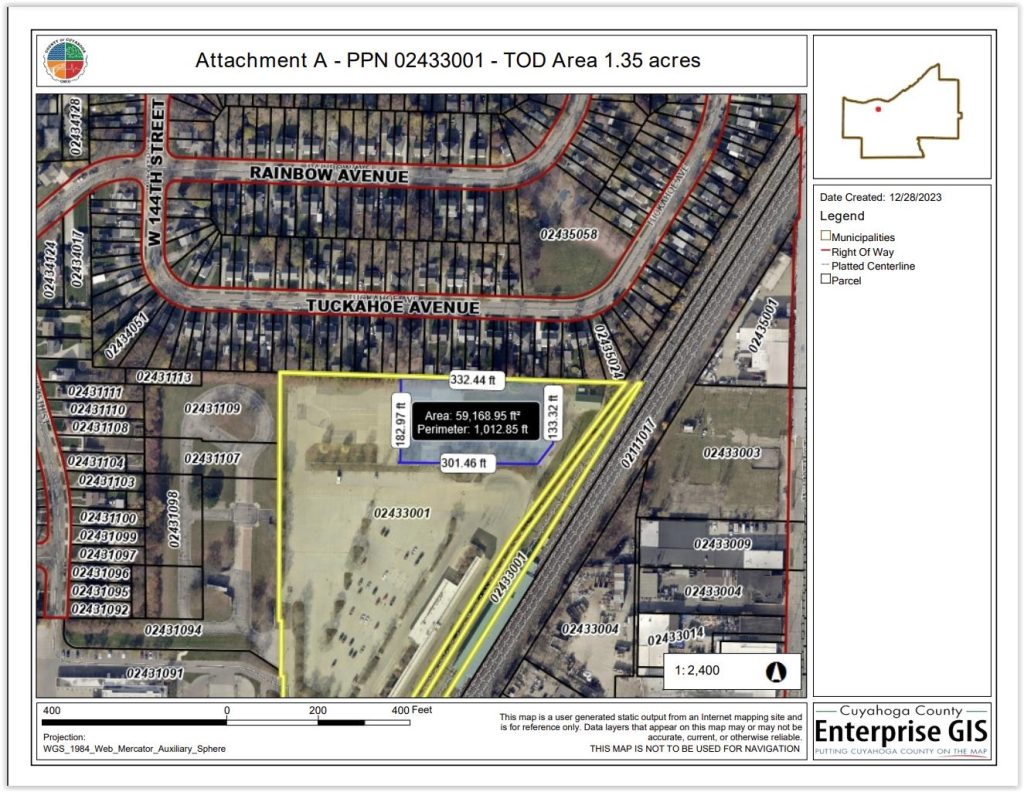
This map show shows the new 1.35-acre parcel that would be carved out of the 14.8-acre West Park station property, then sold by the Greater Cleveland Regional Transit Authority to developer Flaherty & Collins. GCRTA’s station property includes other lands outside of the area outlined in yellow (GCRTA-Cuyahoga County).
The site Flaherty & Collins wants to buy also does not include a GCRTA electrical substation at the extreme northeast corner of the West Park station grounds, or a pedestrian walkway that links the train station to the neighborhood to the north. That walkway ends at Tuckahoe, across the street from the GCRTA-owned Rainbow Park which extends over to Rainbow Avenue.
GCRTA is seeking to rid itself of surplus properties and boost TOD to increase ridership and economic development, all of which is encouraged by the Federal Transit Administration (FTA). Flaherty & Collins’ one-year purchase option would cost the developer $5,000. If it doesn’t buy the land in the first year, the developer can ask for a one-year extension for an additional $5,000. Neither option amount is refundable to the developer. GCRTA and the FTA would have to approve any final purchase.
“During the initial option period, FC (Flaherty & Collins) will prepare and apply for project financing to the state of Ohio to secure tax credit financing to develop the TOD project,” a proposed GCRTA resolution states. “As a requirement for the financing submittal, FC will need to demonstrate site control of the project. An option agreement with the authority will satisfy this financing application requirement.”
The same option-to-purchase approach was taken by Flaherty & Collins and GCRTA in October 2022 for the developer’s proposed Depot on Detroit, a 60-unit apartment building planned to rise on surplus GCRTA land just west of the West Boulevard-Cudell station. That is three stops east of West Park on the Airport-Downtown-Windermere Red Line.
On Friday, Depot on Detroit’s design received final approval with unanimous support from the planning commission’s Design Review Committee. It passed with conditions recommended by the Far West Design Review Committee, namely to add shade trees along Detroit and provide additional exterior lighting.
Last year, Depot on Detroit received $1.25 million in Low Income Housing Tax Credits (LIHTC) and a $1.75 million Housing Development Loan (HDL) from the Ohio Housing Finance Agency (OHFA) plus a $1 million HOME and Emergency Rental Assistance loan from Cuyahoga County. At minimum, LIHTC will be sought to help construct the West Park project, too.
The affordable housing at both stations will be marketed to families and others seeking easy access to public transportation. Depot on Detroit will have one-, two- and three-bedroom units, 60 outdoor parking spaces for cars behind the building, indoor parking for bicycles.
Flaherty & Collins will have to buy the city of Cleveland’s development air rights at the West Park station, as it did next to the West Boulevard-Cudell station for $12,000, public records show. The development sites for both projects are of almost equal size, too. But at this early stage, few details were available for the West Park project.
“A residential TOD was determined to be the highest and best use for this excess property and will promote the TOD and economic development goals of the authority,” GCRTA’s proposed resolution notes. “The TOD project will enhance the value of the existing real estate assets of the West Park rapid transit station.”
Although the West Park station is in Cleveland’s Jefferson neighborhood, it is in the West Park Kamm’s Neighborhood Development’s service area. In 2011, the community development corporation and City Architecture created a development masterplan for Lorain Avenue from Kamm’s Corners to and including the West Park station that was supported by the City Planning Commission.
The station grounds were proposed to have its parking lot reduced in size and moved northward to where the new apartment building is now proposed. South of there, the CDC suggested the old station parking lot, bus training area, post office and former Harley Davidson motorcycle dealership be redeveloped with townhomes, apartments and detached single-family homes.
Park-n-ride lots at all GCRTA stations are vastly underutilized. But if those lots were redeveloped with parking decks, housing and mixed uses, they could offer a significant opportunity to address economic development, urban repopulation efforts and jobs-access opportunities by constructing housing and supportive services.
Last year, NEOtrans found that, if all 21 GCRTA rail station parking lots totaling 30 acres were developed with transit-supportive housing densities and retail, they could host from 750 to 1,050 housing units for 1,800 to 2,520 people with 42,300 to 50,588 square feet of neighborhood retail.
If GCRTA developed all of its properties at these rail stations, it would turn 80 acres into more productive uses. That acreage could host from 2,000 to 2,800 housing units for 4,800 to 6,720 people with 112,800 to 157,920 square feet of neighborhood retail. At nearly 15 acres, West Park station has the second-largest acreage of GCRTA property surrounding a GCRTA rail station. Brookpark station has the most with 21 acres.
And if GCRTA, plus neighboring owners of public and underutilized private properties developed their lands with transit-supportive densities, a total of 232 acres could host 5,800 to 8,120 housing units for 13,920 to 19,488 people with 327,120 to 457,968 SF of neighborhood retail, the NEOtrans analysis reported.
END

